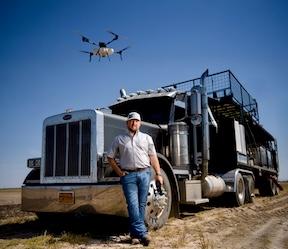
“When I decided to get into drone spraying, my first thought was getting a trailer set up to tender it, but every trailer I looked at was $70,000 or more,” says Arkansas farmer Dalton Dilldine. “I quickly went to Plan B and decided to build one. I searched the internet and located an old 30-ft. military trailer for $3,000 that had $2,500 worth of new tires—a real bargain. In six weeks, we leveled the platform and built it into an efficient two-level tender with tanks, totes, piping and a large battery cabinet, all for less than $35,000.”
Before working on the trailer, Dilldine sketched out several tender designs, each emphasizing efficiency. He searched the internet for ideas, talked extensively with a friend in Missouri, and drew on concepts from an earlier trailer he built for his ground sprayer.
“I wanted to haul and fill the drone efficiently, carry enough materials in one load to cover 550 acres, and pull it with a 379 Peterbilt.”
People thought he was crazy to pull it with a semi tractor because he wouldn’t be able to turn around or back into fields and would probably get stuck. That hasn’t been the case at all.
“When people see me now, they want to take pictures, videos and know everything about how we built it,” Dilldine says.
His tender has a 500-gal. hot mix tank, a 1,200-gal. water tank, a 40-gal. mixing station, and carries various application products. Liquid is moved through 2-in. hoses by two sets of pumps. One pulls fresh water into the hot mix tank, and another recirculates and fills his XAG P150 drone. Designed for speed and efficiency, the system uses a 2-hp 240-volt pump that can move 20 gal. in 10 seconds. He can fill the drone in 48 seconds, thanks to his drone’s 1 1/2-in. fill pipe, which he upsized from the original 3/4-in. size.
Unlike some people whose drones land on the ground for refilling, Dilldine’s drone lands and is transported on the tender’s 32-ft. long upper deck.
“It’s 12 ft. off the ground, so we’re not kicking up dust,” he says. “It’s also close to four 5,000-watt chargers set in an air-conditioned 65-degree cabinet. That’s especially important in the 100-degree days we often have in the summer.”
He has four sets of batteries and always keeps two charged ones ready for when the drone lands. The charging power comes from a 30 kW diesel generator that Dilldine says is large enough to power two big houses.
“I need that much juice for quick recharges,” he says.
It’s very efficient because, in just one season of work, it used only about half the fuel in its diesel tank.
During his first season of drone spraying, Dilldine covered about 5,000 acres, applying burndown and spraying corn, soybeans, rice and cotton. His operation totals 6,000 acres that he previously covered with a ground rig and aerial application.
“The drone took the place of an airplane and was definitely more efficient,” he says. “With its 22-ft. wide swath running about 12-ft. off the ground, I can cover 55 acres an hour.”
He uses an iPad to control the drone, which stores digital files for each field.
“I configure each field with GPS coordinates, start the drone in a corner of a field, then let it work. Before starting and during operation, I check wind velocity and direction, and what’s growing in neighboring fields. It carries 19 gal. of material and sprays at 40 mph. Loaded, it weighs 280 lbs. and sounds like a helicopter when it’s taking off. When its tank is empty, it returns to the tender, setting itself down, ready for refilling.”
Dilldine says it took him nearly a year of planning, researching, talking to his buddy in Missouri, building, and setting up his equipment to get the system running smoothly.
“It’s definitely a learning process, a lot of trial and error, avoiding obstacles like power lines and poles, and figuring things out. I know it’s more efficient than a ground rig or a plane. I’m not damaging crops with sprayer wheels or streaking fields, and I can spray much sooner after a rain than with a wheel rig.
“If this tender-and-drone setup works just as well next year, I might consider building two more tenders, getting two more drones, and selling the ground rig. The biggest issue would be training new operators because it’s a whole different job than running a wheel rig, working a game console, or flying a drone for fun.”
Contact: FARM SHOW Followup, Dilldine Farms, 540 E. State Hwy. 239, Blytheville, Ark. 72315 (daltondilldinefarms@gmail.com).
